Your cart is currently empty!
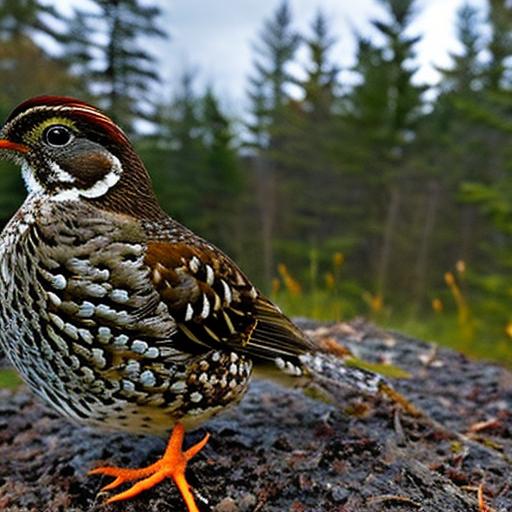
Beginner to Pro: Ruffed Grouse Hunting Tips You Can’t Afford to Miss!

Table of Contents
Introduction
Ah, the thrill of ruffed grouse hunting! There’s nothing quite like the rush of spotting that elusive bird, taking aim, and making a successful shot. But as any seasoned hunter will tell you, the journey from beginner to pro is filled with lessons, some learned the hard way. Whether you’re just starting out or have been hunting for years, there’s always something new to discover in the world of ruffed grouse hunting. That’s the beauty of this sport; it’s ever-evolving and demands continuous learning. This article aims to provide you with ruffed grouse hunting tips that can make a significant difference in your hunting expeditions. From understanding the intricate details of the grouse’s habitat to mastering the art of the approach, these insights come from years of experience and countless hours spent in the woods. So, whether you’re a novice looking to bag your first bird or a seasoned pro seeking to refine your technique, these ruffed grouse hunting tips are tailored just for you.
Understanding the Ruffed Grouse Habitat
One of the foundational ruffed grouse hunting tips that often goes overlooked is the profound importance of truly understanding the bird’s natural habitat. Just as a fisherman must understand the waters he fishes in, a hunter must be intimately familiar with the terrain and habits of his quarry. This knowledge not only increases your chances of a successful hunt but also deepens the connection between you and the natural world.

Ruffed Grouse’s Preferred Terrain
Ruffed grouse are creatures of the forest, but not just any forest will do. These birds have a particular fondness for young, dense woodlands, often those that have been regenerated after logging or a natural event like a forest fire. These areas provide the grouse with ample cover from predators and a rich diet of buds, leaves, and insects. Deciduous forests, especially those dominated by aspen or poplar trees, are prime grouse territory. However, they can also be found in mixed woods with a combination of coniferous and deciduous trees.
Another terrain feature to be aware of is the presence of “drumming logs.” Male ruffed grouse will often find a prominent log or rock from which they’ll produce a drumming sound, a rapid thumping meant to attract females and establish territory. Finding one of these drumming sites can be a goldmine for the hunter, as it indicates a male’s regular presence in the area.
Seasonal Behavior and Location Shifts
Just as the trees shed their leaves and animals prepare for winter, ruffed grouse also undergo behavioral changes with the seasons. Understanding these shifts is crucial for any hunter hoping to consistently find success.
In the spring, as mentioned earlier, males are often preoccupied with drumming to attract a mate. This can make them slightly easier to locate, but also more wary of disturbances. As the summer progresses, grouse tend to move to cooler, denser parts of the forest, often near water sources. They’ll be foraging on the ground, feasting on the abundance of insects, berries, and green shoots.
Come fall, the grouse’s diet begins to shift towards tree buds, especially those of the aspen tree. This is also the prime hunting season for many enthusiasts, as the birds are more active and often less wary. However, as winter approaches, ruffed grouse have a fascinating adaptation. They will burrow into the snow to roost, using it as insulation against the cold winter nights. This behavior can make them challenging to locate, but for the observant hunter, the telltale signs of their snow burrows can lead to a rewarding hunt.
Essential Gear for Every Grouse Hunter
In the realm of hunting, especially when targeting a bird as elusive as the ruffed grouse, having the right gear is paramount. It’s not just about increasing your chances of success; it’s also about ensuring safety, comfort, and efficiency during your hunting expeditions. Let’s delve into the essential gear that every grouse hunter, whether a novice or a seasoned pro, should consider.
Shotguns: From Novice to Expert
When it comes to ruffed grouse hunting, your choice of shotgun can make a significant difference. For beginners, a 20-gauge shotgun is often recommended. It’s lighter than the 12-gauge, making it easier to carry through dense forests, and it offers a manageable recoil. The Remington 870 or the Mossberg 500 are both reliable and affordable options for those just starting out.
For the more experienced hunters, a 12-gauge can be a good choice, especially if you’re hunting in areas where longer shots might be necessary. Over-and-under shotguns, like the Browning Citori or the Beretta Silver Pigeon, are favorites among many seasoned grouse hunters. They offer quick follow-up shots and are well-balanced for walking in the woods.
Dressing the Part: Camouflage and Safety
Your clothing choice is about more than just looking the part; it’s about blending into the environment and ensuring your safety. For grouse hunting, consider wearing earth-toned or forest-patterned camouflage. This helps you blend into the woodland surroundings, making it harder for the grouse to spot you.
However, safety should always be a priority. During hunting season, it’s essential to wear blaze orange vests or hats. This bright color ensures you’re visible to other hunters, reducing the risk of accidents. Look for clothing that offers a combination of camouflage and blaze orange for the best of both worlds.
Tools and Accessories for an Efficient Hunt
Beyond the shotgun and clothing, several tools and accessories can elevate your grouse hunting experience:
- Game Bags: These are essential for carrying your harvested birds. Look for a vest or backpack with built-in game bags for convenience.
- Hunting Boots: A good pair of waterproof, ankle-supporting boots is crucial. You’ll be trekking through uneven and potentially wet terrains, so invest in quality footwear.
- Locator Calls: While not always necessary, a grouse call can help locate birds, especially during the early season when males are more vocal.
- Maps and GPS: Knowing your hunting grounds is essential. While traditional topographic maps are useful, many hunters now rely on GPS devices or smartphone apps that offer detailed maps and tracking features.
- Dog Whistle: If you’re hunting with a dog, a whistle is a must-have. It allows you to communicate with your canine companion effectively, especially in dense woods where verbal commands might not carry.
In essence, while skill and knowledge play a significant role in hunting success, having the right gear is equally crucial. It’s an investment not just in your hunting endeavors but also in your safety and comfort. As with all ruffed grouse hunting tips, remember that the best gear is the one that works for you, fits your needs, and enhances your overall hunting experience.
Advanced Techniques for Spotting and Approaching Grouse
While having the right gear and understanding the habitat of the ruffed grouse are essential, mastering the techniques of spotting and approaching these elusive birds can truly set you apart as a hunter. The dance between hunter and prey is intricate, and understanding the subtle cues and behaviors of the grouse can significantly enhance your hunting experience.
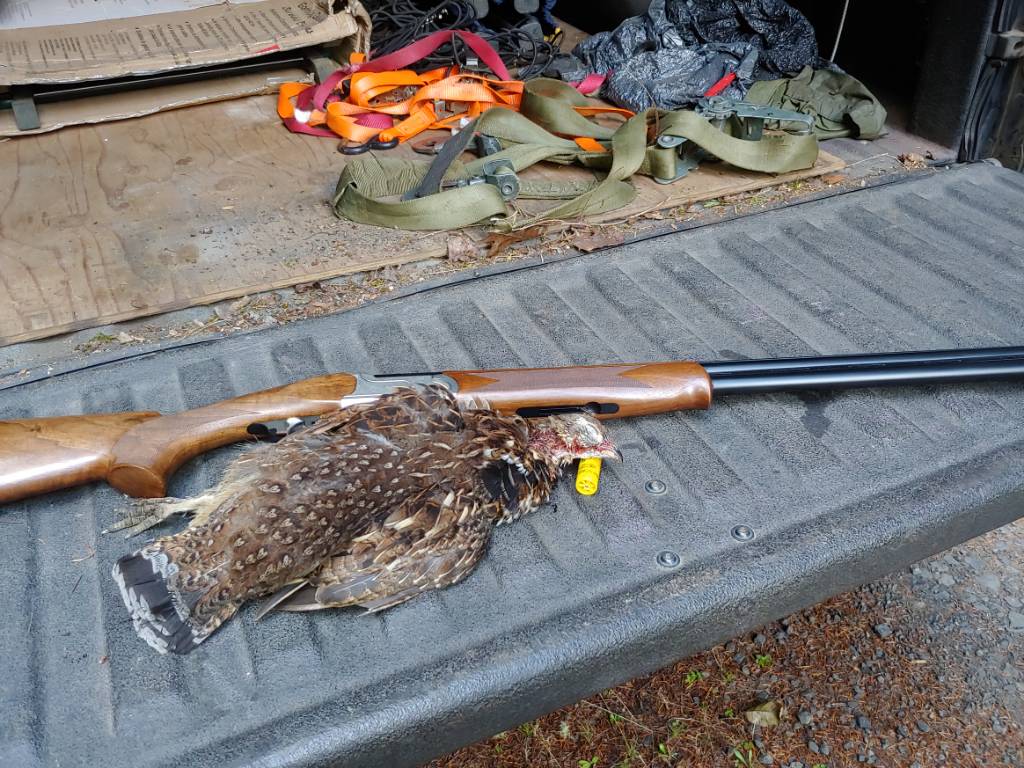
The Art of Spotting Grouse: Signs and Signals
Ruffed grouse, like all creatures, leave behind signs of their presence. To the untrained eye, the woods might seem quiet and devoid of life, but to the seasoned hunter, there are signals everywhere.
Listening for the Distinctive Sounds of Grouse
One of the most iconic sounds in the woods is the drumming of the male ruffed grouse. This rapid, thumping sound is made by the male beating his wings against the air, creating a vacuum. It starts slow and increases in speed, resembling the sound of a distant engine revving up. This drumming is a territorial display meant to attract females and deter other males. Pinpointing the source of this sound can lead you directly to a grouse.
Beyond drumming, the soft clucking or the sudden flush (the sound of the grouse taking off) are other auditory cues to be aware of.
Recognizing Grouse Tracks and Other Signs
Grouse tracks are distinctive, with three forward-pointing toes. In the snow or soft mud, these tracks can be a clear indicator of recent grouse activity. Additionally, look for signs of feeding, such as pecked aspen buds or remnants of clover and other plants.
Approaching Without Startling: The Dance of Stealth and Patience
Once you’ve spotted or heard a grouse, the next challenge is approaching without startling it. This is where the true art of hunting comes into play.
The Role of Wind and Sun Direction
Always be mindful of the wind direction. Approaching grouse from upwind can give away your position, as these birds have an excellent sense of smell. It’s best to approach from downwind or crosswind. Similarly, use the sun to your advantage. Approaching with the sun behind you can cast shadows that alert the grouse. Instead, try to keep the sun to your side or face it directly, ensuring your shadow doesn’t precede you.
Techniques for Silent Movement in the Woods
Moving silently is crucial. Here are some tips:
- Step Softly: Place the heel of your foot down first, rolling onto the ball of your foot. This distributes weight more evenly and reduces the chance of snapping twigs.
- Pause Regularly: Stop occasionally to listen and observe. This not only helps in spotting grouse but also breaks up your movement pattern, making you less detectable.
- Use Natural Barriers: Move behind trees, bushes, or terrain features to break the line of sight between you and the grouse.
Related Questions
What’s the best time of day for grouse hunting?
The optimal times for grouse hunting are during the early morning and late afternoon. These periods are when grouse are most active, typically feeding and moving about. The early morning offers the advantage of the woods still being relatively quiet, allowing you to hear the subtle sounds of grouse activity. Late afternoon, just before dusk, sees grouse searching for their evening meal, making them more susceptible to being spotted. Additionally, the softer lighting during these times can help in spotting the birds against the forest backdrop.
How do you train a dog for grouse hunting?
Training a dog for grouse hunting is a rewarding endeavor that requires patience and consistency. Start with basic obedience commands like “sit,” “stay,” and “come.” Once mastered, introduce the dog to the scent of grouse using feathers or wings. This familiarizes them with their target. Gradually progress to field exercises, allowing the dog to search and point. Positive reinforcement is key. Over time, introduce controlled scenarios with live birds to refine their pointing and retrieving skills. Remember, the bond between hunter and dog is crucial, so spend quality time together, building trust and understanding.
What are the common mistakes beginners make when hunting grouse?
Beginners often make a few common mistakes when hunting grouse. First, they might move too quickly through the woods, missing subtle signs of grouse activity or startling the birds before getting a clear shot. Another mistake is neglecting to study the habitat and behavior of the grouse, leading to less effective hunting strategies. Some beginners also rely too heavily on gear, thinking it will compensate for lack of experience. Lastly, not practicing shooting enough can result in missed opportunities. It’s essential to remember that patience, observation, and practice are key components of successful grouse hunting.
How can I improve my shooting accuracy for grouse hunting?
Improving shooting accuracy for grouse hunting involves both technical practice and mental preparation. Regularly practice shooting at clay pigeons or other moving targets to simulate the unpredictable flight of a grouse. Focus on your stance, grip, and swing-through. Mentally, visualize successful shots and stay calm when the moment arrives. Remember, grouse often flush unexpectedly, so train yourself to react quickly but smoothly. Additionally, familiarize yourself with your shotgun; understand its weight, balance, and trigger pull. Over time, consistent practice and real-world experience will enhance your accuracy and confidence.
Summary
In the world of hunting, knowledge truly is power. The insights shared in this article, rooted in years of experience, aim to elevate your ruffed grouse hunting game. Understanding the grouse’s habitat, investing in the right gear, and mastering advanced techniques are all crucial components of a successful hunt. But remember, ruffed grouse hunting tips are just the beginning. The real magic happens when you’re out there in the woods, connecting with nature, and putting these tips into practice. Continuous learning, patience, and respect for the environment are the hallmarks of a great hunter. As you venture out on your next expedition, armed with these ruffed grouse hunting tips, may you experience the thrill of the hunt in its purest form. And always remember, hunting is not just about the catch; it’s about the journey, the connection with nature, and the stories you’ll have to tell. Happy hunting!

Herb has been a longtime lover of the outdoors. Whether it be hunting, camping, fishing or just getting outside to reset. Proud father and animal lover. Bourbon anyone?

by
Comments
2 responses to “Beginner to Pro: Ruffed Grouse Hunting Tips You Can’t Afford to Miss!”
-
[…] equip you with tips honed by experience—not just hearsay—that will transform idle time into prime hunting opportunities. So keep reading because it’s about high time those wary birds learned what it […]
-
[…] might also be interested in learning some tips for ruffed grouse hunting. Check out this article on ruffed grouse hunting tips to enhance your hunting skills and increase your chances of a successful […]

Categories
- Big Game Hunting (301)
- Deer (202)
- Reviews (3)
- Shooting (16)
- Slingshot (1)
- Small Game Hunting (42)
- Upland Hunting (126)
- Waterfowl Hunting (3)

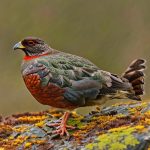
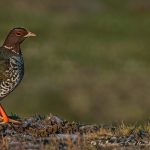
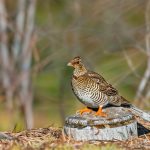
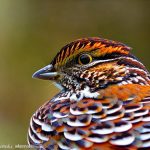
Leave a Reply